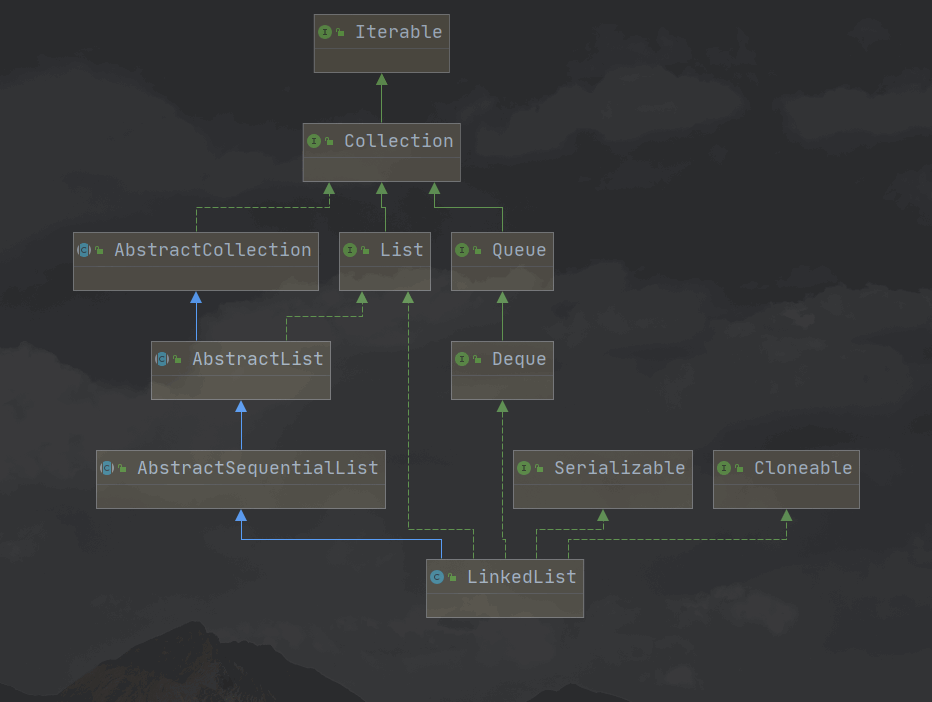1. 概念
队列是在JDK1.5中被引入,它是一种数据结构,遵循原则就是 “FIFO”,即”先进先出”。
Queue接口与List同一级别,继承自Collection接口,LinkedList实现了Deque接 口。

2. 分类
队列在实际应用有很多分类,如是否阻塞、是否线程安全、是否有界。这里也仅从这三块来加以区分。
| 类名 | 是否阻塞 | 是否线程安全 | 是否有界 | 特点 |
|---|---|---|---|---|
| LinkedList | 非阻塞 | 线程安全 | 有界 | 基于链表 |
| ArrayBlockingQueue | 阻塞 | 线程安全 | 有界 | 基于数组的有界队列 |
| LinkedBlockingQueue | 阻塞 | 线程安全 | 可选有界 | 基于链表的无界队列 |
| ConcurrentLinkedQueue | 非阻塞 | 线程安全 | 无界 | 基于链表 线程安全的队列 |
| PriorityBlockingQueue | 阻塞 | 线程安全 | 无界 | 基于优先次序的无界队列 |
| PriorityQueue | 非阻塞 | 非线程安全 | 无界 | |
| SynchronousQueue | 阻塞 | 线程安全 | 无数据队列 | 内部没有容器的队列 较特别 |
| LinkedBlockingDeque | 阻塞 | 线程安全 | 无界 | |
| DelayQueue | 阻塞 | 线程安全 | 无界 | 基于时间优先级的队列 |
2.1. 队列容量
从队列的大小以及容量来说,分为 有界队列、无界队列
2.2. 阻塞
从阻塞特征来说,分为 阻塞队列、非阻塞队列
2.3. 线程安全
从线程安全来说,分为 线程安全、非线程安全
2.4. LinkedList
2.4.1. 适用场景
通常适用与插入元素和删除元素,时间的复杂度O(1)。它性能高效的原理是通过链表实现,插入和删除只需要改变前后两个节点指针指向即可。
2.4.2. 构造函数
1 | /** |
2.4.3. 常用方法
| 方法名 | 描述 |
|---|---|
| element | 检索但不删除此列表的头(第一个元素) |
| getFirst | 返回此列表中的第一个元素 |
| getLast | 返回此列表中的最后一个元素 |
| offer | 将指定的元素添加为此列表的尾部 |
| poll | 检索并删除此列表的头(第一个元素) |
| pop | 从此列表表示的堆栈中弹出一个元素,换句话说,删除并返回此列表的第一个元素 |
| peek | 检索但不删除此列表的头(第一个元素) |
2.4.4. 样例
1 | public static void main(String[] args) { |
2.5. CoucurrentLinkedQueue
同步队列,无界
3. 阻塞队列
在java.util.concurrent 包中加入 BlockingQueue 接口和五个阻塞队列类。它实质上就是一种带有一点扭曲的 FIFO 数据结构。不是立即从队列中添加或者删除元素,线程执行操作阻塞,直到有空间或者元素可用
3.1. ArrayBlockingQueue
有界
3.2. LinkedBlockingQueue
- 构造方法
- drainTo()
无界
3.3. 优先级阻塞队列PriorityBlockingQueue
每次调用take方法获取元素的时候将优先级最高的返回出来!
3.4. 延迟阻塞队列DelayQueue
3.5. SynchronousQueue
容器中不支持直接加元素,需要take线程与add线程阻塞集合
3.6. 阻塞队列BlockingQueue
3.6.1. ArrayBlockingQueue
有界
3.6.2. LinkedBlockingQueue
- 构造方法
- drainTo()
无界
3.6.3. SynchronousQueue
容器中不支持直接加元素,需要take线程与add线程阻塞集合
3.6.4. 优先级阻塞队列PriorityBlockingQueue
每次调用take方法获取元素的时候将优先级最高的返回出来!